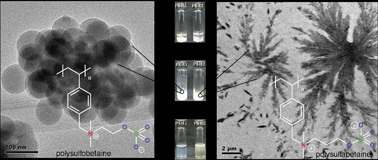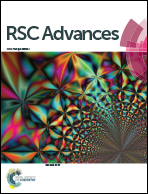Halophilic polysulfabetaines – synthesis and study of gelation and thermoresponsive behavior†
Abstract
Polysulfabetaines (PSBs) derived from zwitterionic sulfates (contrary to commonly used polysulfobetaines which are derived from zwitterionic sulfonates) were synthesized for the first time. PSBs dissolved in brine (halophilic), swelled in deionized water and also exhibited reversible and irreversible thermoresponsive behavior. Large differences in interaction with deionized water and brine solution as well as morphology of particles in dispersion was observed between poly[2-(dimethyl(4-vinylbenzyl)ammonio)ethyl sulfate] (PSB 1) and poly[3-(dimethyl(4-vinylbenzyl)ammonio)propyl sulfate] (PSB 2) even though a single methylene (–CH2–) unit was the sole differentiating factor. The gelation and thermoresponsive behaviour observed in PSBs are similar to that of naturally occurring polymers.


 Please wait while we load your content...
Please wait while we load your content...